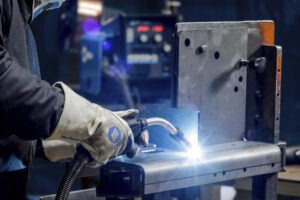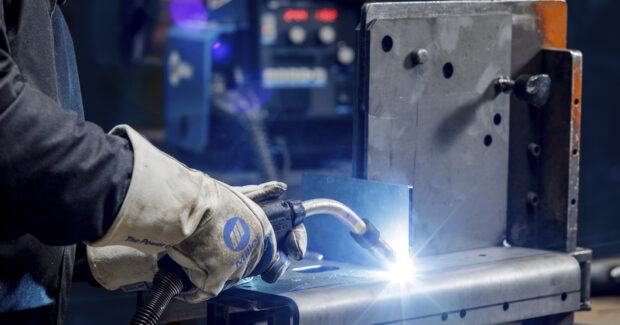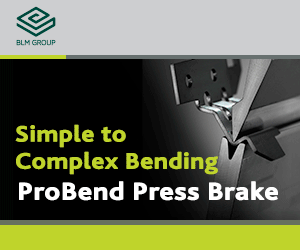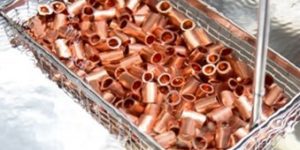Five Factors to Consider When Choosing a MIG Welding Gun
Choosing the right MIG gun directly affects efficiency, quality and safety — a trifecta every operator is trying to master to create a more comfortable and effective environment.
Posted: April 25, 2024

MIG welding is considered one of the easiest welding processes to learn and is useful for a variety of applications and industries. The versatility and speed of MIG welding also make it a good option for all-position welding on various metals, including mild and stainless steels, and in a range of thicknesses. In addition, it produces a cleaner weld that requires less cleanup than stick or flux-cored welding.
To maximize the benefits this versatile process offers, it is imperative to select the right MIG gun for the job. In fact, this equipment’s specifications can significantly impact productivity, downtime, weld quality and operating costs — as well as welding operators’ comfort. Take into account these five factors when choosing the right MIG gun for your needs.
- Consider duty cycle, amperage and shielding gas.
One of the most common mistakes is buying a gun based on amperage alone and failing to consider duty cycle. Duty cycle is all about safety and refers to the number of minutes in a 10-minute period that a gun can be operated at its full capacity without overheating and becoming too hot to handle. Manufacturers can rate their guns at 100% or 60% duty cycles, causing significant differences when comparing different MIG gun manufacturers’ products.
For example, a 60% duty cycle means six minutes of arc-on time in a 10-minute span. Because most welding operators don’t weld 100% of the time — they’re moving parts, tacking them and performing other pre- and post-weld activities — it is often possible to use a lower-amperage gun for a welding procedure that calls for a higher-amperage one. It’s often better to choose the lightest, most flexible gun that meets your needs because a MIG gun with higher amperage capacity than you need typically weighs more and may be less flexible, making it less comfortable to maneuver around weld joints. However, if an operation needs a lot of arc-on time, choosing a gun with a 100% duty cycle may be the best option to ensure a full 10 minutes of welding without overheating the gun. It’s ideal to strike a balance between duty cycle performance and the weight of the gun. High-duty cycle makes for continuous operation, but a lighter gun is best for operator comfort and maneuverability.
It’s also important to consider the shielding gas that will be used when evaluating a gun’s amperage. Most guns are tested and rated for duty cycle according to their performance with 100% CO2 because this shielding gas tends to keep the gun cooler during operation. Conversely, a mixed-gas combination, such as 75% argon and 25% CO2, makes the arc hotter and therefore causes the gun to run hotter, reducing duty cycle. For example, if a gun is rated at 100% duty cycle (based on the industry-standard testing with 100% CO2), its rating with mixed gases will be lower. If a gun is rated at only 60% duty cycle with CO2, the use of mixed gases will cause the gun to operate hotter and become less durable.
- Choose amperage based on wire size and weldment length.
Proper weld penetration and quality come down to a crucial decision: choosing the correct amperage based on wire size. Because amperage influences the heat input into the welding process, selecting the right amperage ensures that the wire melts at the correct rate for the given diameter. When it comes to longer weldments, they generally require higher amperage across the entire length of the weld to allow for proper fusion and penetration.
Some general guidelines across both variables to consider include:
- Material thickness: Thicker materials need higher amperage.
- Welding position: Welding in vertical or overhead positions may need higher amperage to ensure proper fusion.
- Metal type: Different base materials have different thermal properties, which can impact the amperage needed.
- Preheating: In some instances, and notably with longer weldments and thicker materials, preheating the base metal may be necessary to reduce the cooling rate, mitigate warpage and enhance the quality of the weld.
- Multi-pass welding: Long weldments may require a multi-pass approach. The amperage for each pass then needs to be adjusted, taking into account the combined heat input from each and whether the penetration is sufficient.
- Determine whether you need a water- or air-cooled gun.
Deciding between a water- or air-cooled MIG gun depends largely on the application and amperage requirements, welding operator’s preference and budget. Each system has its advantages and disadvantages. Water-cooled guns are more expensive upfront and can require more maintenance and operational costs. However, water-cooled guns can be much lighter and more flexible than air-cooled guns, so they can provide productivity advantages by reducing operator fatigue. But because water-cooled guns require more equipment, they can also be impractical for applications that require portability.
Here’s how these two guns work to protect the power cable, gun and consumables from heat damage:
- Water-cooled guns: A water-cooled MIG welding system pumps cooling solution from a radiator unit, usually integrated inside or near the power source, through hoses inside the cable bundle and into the gun handle and neck. The coolant then returns to the radiator, where a baffling system releases the heat absorbed by the coolant. The ambient air and shielding gas further disperse the heat from the welding arc. Shops with stationary equipment that repeatedly weld at 600 amps will likely need a water-cooled MIG gun to handle the heat these applications generate, but water-cooled guns typically range from 300 amps to 600 amps.
- Air-cooled guns: Conversely, an air-cooled system relies solely on the ambient air and shielding gas to dissipate the heat that builds up along the length of the welding circuit. These systems, which range from 150 amps to 600 amps, use much thicker copper cabling than water-cooled systems.
4. Heavy- versus light-duty guns.
While a lower-amperage gun can be appropriate for some applications, be sure it offers the necessary welding capacity for the job. Characteristics and benefits of a light-duty MIG gun:
- A light-duty MIG gun is often the best choice for applications that require short arc-on times, such as tacking parts or welding sheet metal.
- Light-duty guns typically provide 100 amps to 300 amps of capacity, and they tend to be smaller and weigh less than heavier-duty guns.
- Most light-duty MIG guns have small, compact handles as well, making them more comfortable for the welding operator.
- Light-duty MIG guns offer standard features at a lower price. They use light- or standard-duty consumables (nozzles, contact tips and retaining heads), which have less mass and are less expensive than their heavy-duty counterparts.
Conversely, based on the application at hand, a heavy-duty gun may be the best way to go to ensure complete fusion and high-quality welds. Characteristics and benefits of a heavy-duty MIG gun:
- Heavy-duty MIG guns are the best choice for jobs that require long arc-on times or multiple passes on thick sections of material, including many applications found in heavy equipment manufacturing and other demanding welding jobs.
- These guns generally range from 400 amps to 600 amps and are available in air- and water-cooled models.
- They often have larger handles to accommodate the larger cables that are required to deliver these higher amperages.
- The guns frequently use heavy-duty front-end consumables that are capable of withstanding high amperages and longer arc-on times. The necks are often longer as well, to put more distance between the welding operator and the high heat output from the arc.
5. Other considerations: cables and handles.
When it comes to cable selection, choosing the smallest, shortest and lightest cable capable of handling the amperage can offer greater flexibility, making it easier to maneuver the MIG gun and minimize clutter in the workspace. Manufacturers offer industrial cables ranging from 8’-to-25’ long. The longer the cable, the more chance it can get coiled around things in the weld cell or looped on the floor and possibly disrupt wire feeding.
However, sometimes a longer cable is necessary if the part being welded is very large or if welding operators must move around corners or over fixtures to finish the task at hand. In these cases, where operators are moving back and forth between long and short distances, a steel mono coil cable might be the better choice. This type of cable doesn’t kink as easily as standard industrial cables and can provide smoother wire feeding.
A MIG gun’s handle and neck design can impact how long an operator can weld without experiencing fatigue. Handle options include straight or curved, both of which come in vented styles. The choice often boils down to welding operator preference. A straight handle is the best choice for operators who prefer a trigger on top, because curved handles for the most part do not offer this option. With a straight handle, the operator can rotate the neck to place the trigger on top or on bottom. This is also a good option for out-of-position welding, allowing you to reach unique welding positions more easily. A curved handle is good for table and in-position welding because there are fewer obstacles to work around. It also provides maximum ergonomic conditions for increased operator comfort.
Choosing the right MIG gun directly affects efficiency, quality and safety — a trifecta every operator is trying to master to create a more comfortable and effective environment. A MIG gun that offers the best comfort and operates at the coolest temperature allowed by the application can help improve arc-on time and productivity — and, ultimately, increase the profitability of the welding operation.


















